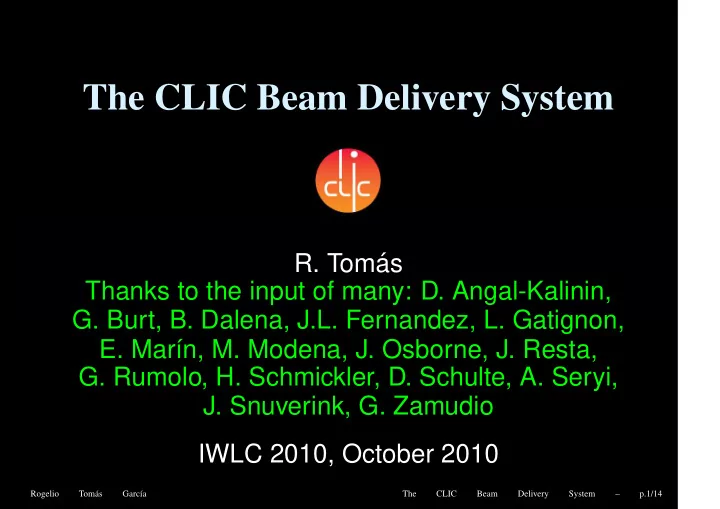

The CLIC Beam Delivery System R. Tom´ as Thanks to the input of many: D. Angal-Kalinin, G. Burt, B. Dalena, J.L. Fernandez, L. Gatignon, E. Mar´ ın, M. Modena, J. Osborne, J. Resta, G. Rumolo, H. Schmickler, D. Schulte, A. Seryi, J. Snuverink, G. Zamudio IWLC 2010, October 2010 Rogelio Tom´ as Garc´ ıa The CLIC Beam Delivery System – p.1/14
Contents • The BDS CDR chapter • CLIC BDS layouts • Subsystems • Issues & challenges • Summary & outlook Rogelio Tom´ as Garc´ ıa The CLIC Beam Delivery System – p.2/14
The BDS CDR chapter “Live” Draft at: clicr.web.cern.ch/CLICr/MainBeam/BDS/CDR/TEX Everybody is welcome to take a look and send criticism to: D. Angal-Kalinin (CI), A. Seryi (JAI) and R. Tom´ as (CERN) Rogelio Tom´ as Garc´ ıa The CLIC Beam Delivery System – p.3/14
The BDS layouts at 3 TeV and 500 GeV Guillermo Zamudio 0.2 0 3 TeV -0.2 IP x[m] -0.4 -0.6 -0.8 500 GeV -1 -2500 -2000 -1500 -1000 -500 0 s[m] 3 TeV needs weak dipoles (20-120 G) due to SR. To keep the linac unchanged the IP crossing angle at 500 GeV is reduced to 18.6 mrad. Both BDS easily fit in same tunnel. Rogelio Tom´ as Garc´ ıa The CLIC Beam Delivery System – p.4/14
Diagnostics and Energy collimation 200 120 β x β x 180 β x,y [km], D x [cm] β y 100 160 β y 140 D x 80 β x,y [m] 120 100 60 80 40 60 40 20 20 0 0 -2800 -2600 -2400 -2200 -2000 -1800 0.2 0.1 laser wires energy 0 x[m] spoiler Polarization IP laser -0.1 Coupling absorver -0.2 correction -0.3 -0.4 -2800 -2600 -2400 -2200 -2000 -1800 s[m] σ y = 1 µ m at laser wires. Energy spoiler must survive a full train impact. Rogelio Tom´ as Garc´ ıa The CLIC Beam Delivery System – p.5/14
Transverse collimation and FFS 600 300 β x,y [km], D x [mm] β x 250 500 β y 200 400 β x,y [m] D x 150 300 100 200 50 100 0 0 -50 -1000 -800 -600 -200 0 0.2 0.1 FD 0 betatron collimators x[m] -0.1 crab -0.2 cavity -0.3 muon spoilers -0.4 -1000 -800 -600 -400 -200 0 s[m] Betatron collimators are consumable. Muon spoilers reduce the muon flux in the detector. Crab cavity restores the luminosity loss from a 20 mrad crossing. Rogelio Tom´ as Garc´ ıa The CLIC Beam Delivery System – p.6/14
Low field dipoles Cherril Spencer (SLAC) Measurements show no enhancements of multi- poles at 1/140 of the design current. Insulation from stray fields? Rogelio Tom´ as Garc´ ıa The CLIC Beam Delivery System – p.7/14
Collimation L L L F T T ��������� ��������� ���������� ���������� ���� ���� � � ���������������������� ���������������������� ���� ���� � � ���������������������� ���������������������� φ � � ���������������������� ���������������������� � � ���������������������� ���������������������� � � ���������������������� ���������������������� � � ���������������������� ���������������������� ������� ������� � � ���������������������� ���������������������� θ b � � ���������������������� ���������������������� � � ���������������������� ���������������������� T � � ���������������������� ���������������������� ������� ������� d � � ���������������������� ���������������������� � � ���������������������� ���������������������� � � a z � � � � � � � � ������������������������������ ������������������������������ Javier Resta (Oxford) Luis Fernandez (CI) Simulation galore confirming: collimation effi- ciency, moderate wakefileds effects, survivability of 1 st spoiler (temperature & stress), etc. Rogelio Tom´ as Garc´ ıa The CLIC Beam Delivery System – p.8/14
Muons Lawrence Deacon (RHUL) A factor 10 reduction in muon flux with 83 m of magnetized iron (outer radius 55 cm). Rogelio Tom´ as Garc´ ıa The CLIC Beam Delivery System – p.9/14
Crab Cavities Graeme Burt, Amos Dexter et al Tight phase stability specs and high order mode damping. Recently found that by design (optics) there is ≈ 5% lumi loss! Rogelio Tom´ as Garc´ ıa The CLIC Beam Delivery System – p.10/14
The FFS: CLIC Vs ILC ILC CLIC Negligible SR 20% lumi loss from SR σ y ≈ 1 nm σ y ≈ 6 nm β y = 70 µ m β y = 400 µ m Chroma. ≈ 6 . 3 × 10 4 Chroma. ≈ 1 . 5 × 10 4 IP D ′ x = 1.4 mrad IP D ′ x = 9 mrad Energy spread ≈ 0.3% Energy spread ≈ 0.1% CLIC FFS is considerably more challenging in every aspect. ATF2 is the common playground but CLIC requires Ultra-low IP β (see E. Mar´ ın’s talk). Rogelio Tom´ as Garc´ ıa The CLIC Beam Delivery System – p.11/14
L* alternatives and performance L* total lumi peak lumi 10 34 cm − 2 s − 1 10 34 cm − 2 s − 1 m 3.5 6.9 2.5 4.3 6.4 2.4 6 5.0 2.1 8 4.0 1.7 Rogelio Tom´ as Garc´ ıa The CLIC Beam Delivery System – p.12/14
Tuning performance for different L* B. Dalena & G. Zamudio relative absolute L* prealignment success success [m] [ µ m] [%] [%] 87 ∗ 3.5 10 65 4.3 10 80 100 6 8 80 90 8 2 80 46 ∗ Recently improved by a better design and the use of knobs Rogelio Tom´ as Garc´ ıa The CLIC Beam Delivery System – p.13/14
Summary & outlook • CLIC BDS CDR chapter well advanced ( waiting for your feedback! ) • No major problem... • Thanks to excellent international collaborations! • Alignment and tuning remains as the biggest challenge → lots to learn in ATF2! • For the TDR phase: • New designs that consider tuning and CCs from the start? • wakefields in FACET Rogelio Tom´ as Garc´ ıa The CLIC Beam Delivery System – p.14/14
Recommend
More recommend